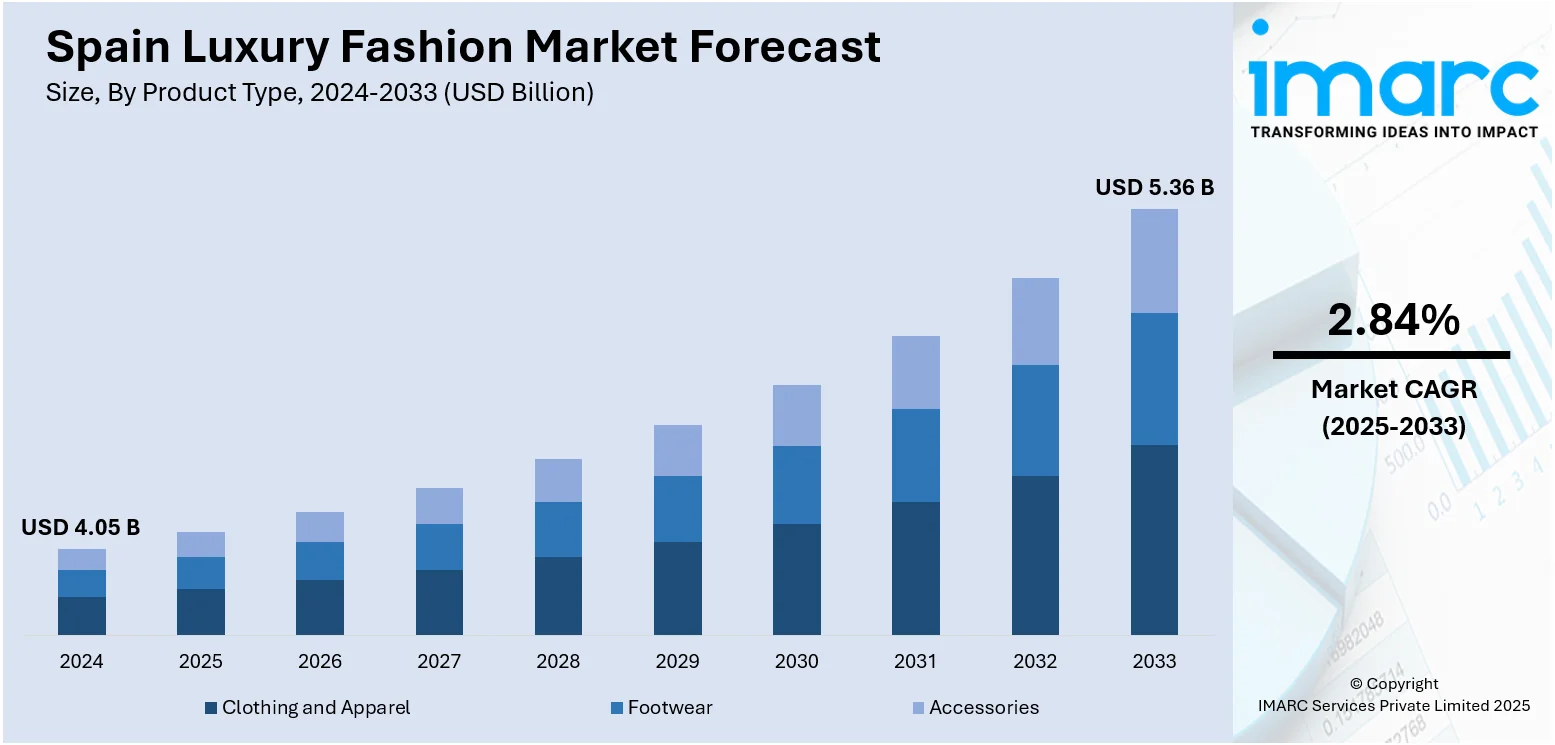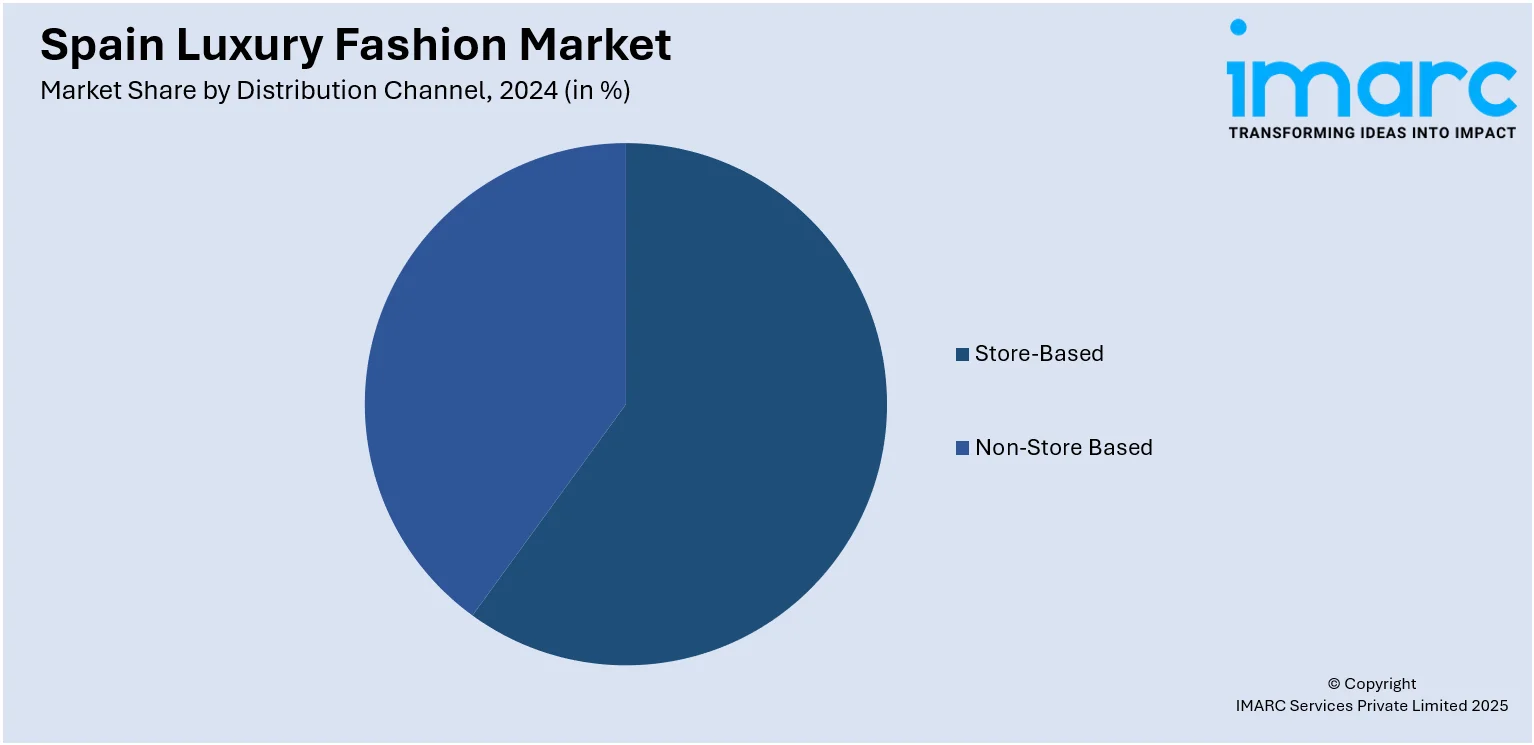
Spain Luxury Fashion Market Size, Share, Trends and Forecast by Product Type, Distribution Channel, End User, and Region, 2025-2033
Spain Luxury Fashion Market Overview:
The Spain luxury fashion market size reached USD 4.05 Billion in 2024. The market is projected to reach USD 5.36 Billion by 2033, exhibiting a growth rate (CAGR) of 2.84% during 2025-2033. The market is fueled by rising disposable incomes, increased international tourism, and strong demand for premium brands across major cities like Madrid and Barcelona. Moreover, market growth is further supported by expanding e-commerce platforms, which make high-end products more accessible to younger consumers. Besides that, brand investments in flagship stores and tailored shopping experiences have helped reinforce customer loyalty and spending, which is a significant factor augmenting the Spain luxury fashion market share.
|
Report Attribute
|
Key Statistics
|
|---|---|
|
Base Year
|
2024
|
|
Forecast Years
|
2025-2033
|
|
Historical Years
|
2019-2024
|
| Market Size in 2024 | USD 4.05 Billion |
| Market Forecast in 2033 | USD 5.36 Billion |
| Market Growth Rate 2025-2033 | 2.84% |
Spain Luxury Fashion Market Trends:
Increasing Disposable Income and Affluent Consumer Base
The market has seen sustained growth due to rising disposable income among middle- and upper-income segments. As per industry reports, over the decade leading up to 2024, Spain’s economy registered an average annual growth of 4.1% in disposable incomes. In 2024 alone, disposable incomes saw a significant rise of 8.7%. The economic recovery and wage improvements, particularly in urban centers, have boosted consumer confidence and spending capacity. This upward shift has allowed a broader demographic to access luxury fashion, moving beyond legacy high-net-worth individuals to include younger professionals and entrepreneurs. Moroever, luxury purchases are no longer limited to status symbols but are increasingly integrated into daily fashion choices. This evolution is also reflected in demand for accessible luxury and premium diffusion lines, which offer prestige branding without the price of haute couture. Additionally, cities like Madrid, Barcelona, Valencia, and Bilbao are seeing concentrated growth, supported by a cosmopolitan consumer base and increased tourism. Wealth concentration in these areas also attracts luxury flagship stores, enhancing local access to global brands. International shoppers, especially from China, the US, and the Middle East, contribute significantly during peak travel seasons, further amplifying the impact of rising purchasing power on luxury sales in Spain.

To get more information on this market, Request Sample
Expanding E-Commerce Platforms and Digital Integration
Digital transformation is positively impacting the Spain luxury fashion market growth. Luxury brands that once relied heavily on physical retail have embraced online platforms to reach broader audiences. Spain’s digitally savvy consumers increasingly prefer online browsing, with mobile purchases showing marked growth. An industry report published in December 2024 revealed that the number of online shoppers in Spain has climbed to 30 Million, reinforcing the sustained growth of the country’s digital retail sector. As a result, brands are optimizing their websites, adopting omnichannel strategies, and partnering with established platforms and multi-brand Spanish e-tailers. Apart from this, e-commerce growth has also enabled smaller domestic luxury labels to compete by increasing visibility and international reach without the overhead of physical retail. Additionally, luxury fashion houses are leveraging advanced CRM systems, artificial intelligence (AI) based personalization, and virtual try-ons to refine the customer journey. Also, social commerce, especially via Instagram and TikTok, has emerged as a significant channel for product discovery and brand engagement, particularly among younger consumers. This shift supports real-time engagement and quicker sales conversion, which is critical in maintaining relevance in a competitive landscape.
Spain Luxury Fashion Market Segmentation:
IMARC Group provides an analysis of the key trends in each segment of the market, along with forecasts at the country and regional levels for 2025-2033. Our report has categorized the market based on product type, distribution channel, and end user.
Product Type Insights:
- Clothing and Apparel
- Jackets and Coats
- Skirts
- Shirts and T-Shirts
- Dresses
- Trousers and Shorts
- Denim
- Underwear and Lingerie
- Others
- Footwear
- Accessories
- Gems and Jewellery
- Belts
- Bags
- Watches
The report has provided a detailed breakup and analysis of the market based on the product type. This includes clothing and apparel (jackets and coats, skirts, shirts and T-shirts, dresses, trousers and shorts, denim, underwear and lingerie, and others), footwear, and accessories (gems and jewellery, belts, bags, and watches).
Distribution Channel Insights:

- Store-Based
- Non-Store Based
A detailed breakup and analysis of the market based on the distribution channel have also been provided in the report. This includes store-based and non-store based.
End User Insights:
- Men
- Women
- Unisex
The report has provided a detailed breakup and analysis of the market based on the end user. This includes men, women, and unisex.
Regional Insights:
- Northern Spain
- Eastern Spain
- Southern Spain
- Central Spain
The report has also provided a comprehensive analysis of all the major regional markets, which include Northern Spain, Eastern Spain, Southern Spain, and Central Spain.
Competitive Landscape:
The market research report has also provided a comprehensive analysis of the competitive landscape. Competitive analysis such as market structure, key player positioning, top winning strategies, competitive dashboard, and company evaluation quadrant has been covered in the report. Also, detailed profiles of all major companies have been provided.
Spain Luxury Fashion Market News:
- June 2025: Palomo Spain marked a significant milestone by unveiling its inaugural womenswear line, expanding the brand's identity beyond its established gender-fluid menswear heritage. The house is now strategically positioned for growth across retail, wholesale, and e-commerce channels. The new Resort 2026 "Cocoon" collection offers silk blouses, floral prints, and feather‑embellished pieces, all rooted in southern Spanish aesthetics and designed to address both women and men across body types.
- February 2024: Amazon expanded its luxury offering in Europe by partnering with the designer resale platform Hardly Ever Worn It to introduce pre-owned luxury items on Luxury Stores at Amazon in the UK, Spain, Germany, and Italy. The curated selection includes women's ready‑to‑wear, shoes, jewelry, accessories, and watches from high‑end designer brands, all subject to a rigorous quality screening process. This move reinforces Amazon's strategy to innovate in luxury retail by broadening accessible, circular-fashion options for its customers.
Spain Luxury Fashion Market Report Coverage:
| Report Features | Details |
|---|---|
| Base Year of the Analysis | 2024 |
| Historical Period | 2019-2024 |
| Forecast Period | 2025-2033 |
| Units | Billion USD |
| Scope of the Report |
Exploration of Historical Trends and Market Outlook, Industry Catalysts and Challenges, Segment-Wise Historical and Future Market Assessment:
|
| Product Types Covered |
|
| Distribution Channels Covered | Store-Based, Non-Store Based |
| End Users Covered | Men, Women, Unisex |
| Regions Covered | Northern Spain, Eastern Spain, Southern Spain, Central Spain |
| Customization Scope | 10% Free Customization |
| Post-Sale Analyst Support | 10-12 Weeks |
| Delivery Format | PDF and Excel through Email (We can also provide the editable version of the report in PPT/Word format on special request) |
Key Questions Answered in This Report:
- How has the Spain luxury fashion market performed so far and how will it perform in the coming years?
- What is the breakup of the Spain luxury fashion market on the basis of product type?
- What is the breakup of the Spain luxury fashion market on the basis of distribution channel?
- What is the breakup of the Spain luxury fashion market on the basis of end user?
- What is the breakup of the Spain luxury fashion market on the basis of region?
- What are the various stages in the value chain of the Spain luxury fashion market?
- What are the key driving factors and challenges in the Spain luxury fashion market?
- What is the structure of the Spain luxury fashion market and who are the key players?
- What is the degree of competition in the Spain luxury fashion market?
Key Benefits for Stakeholders:
- IMARC’s industry report offers a comprehensive quantitative analysis of various market segments, historical and current market trends, market forecasts, and dynamics of the Spain luxury fashion market from 2019-2033.
- The research report provides the latest information on the market drivers, challenges, and opportunities in the Spain luxury fashion market.
- Porter's five forces analysis assist stakeholders in assessing the impact of new entrants, competitive rivalry, supplier power, buyer power, and the threat of substitution. It helps stakeholders to analyze the level of competition within the Spain luxury fashion industry and its attractiveness.
- Competitive landscape allows stakeholders to understand their competitive environment and provides an insight into the current positions of key players in the market.
Need more help?
- Speak to our experienced analysts for insights on the current market scenarios.
- Include additional segments and countries to customize the report as per your requirement.
- Gain an unparalleled competitive advantage in your domain by understanding how to utilize the report and positively impacting your operations and revenue.
- For further assistance, please connect with our analysts.
 Request Customization
Request Customization
 Speak to an Analyst
Speak to an Analyst
 Request Brochure
Request Brochure
 Inquire Before Buying
Inquire Before Buying




.webp)




.webp)












